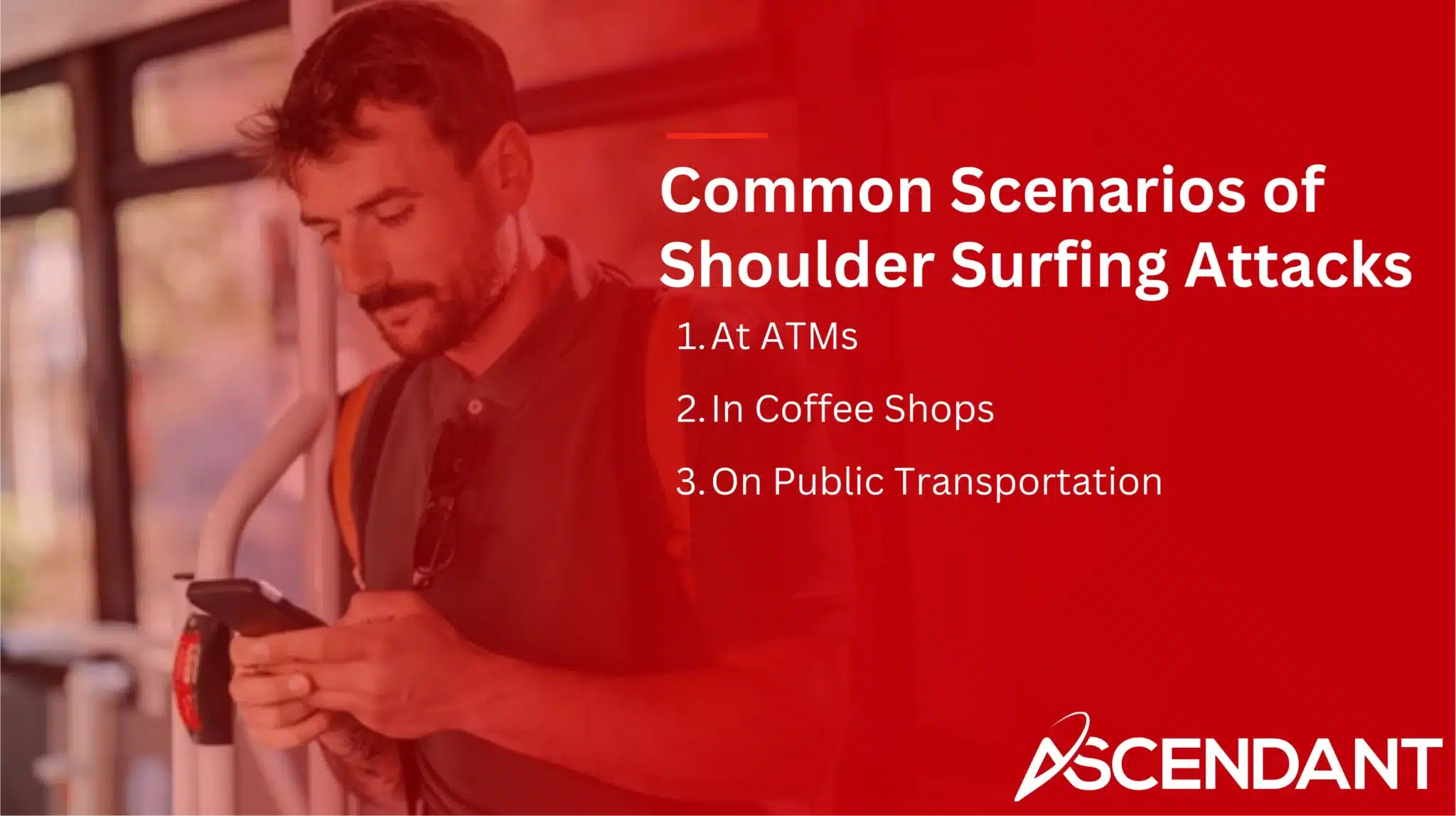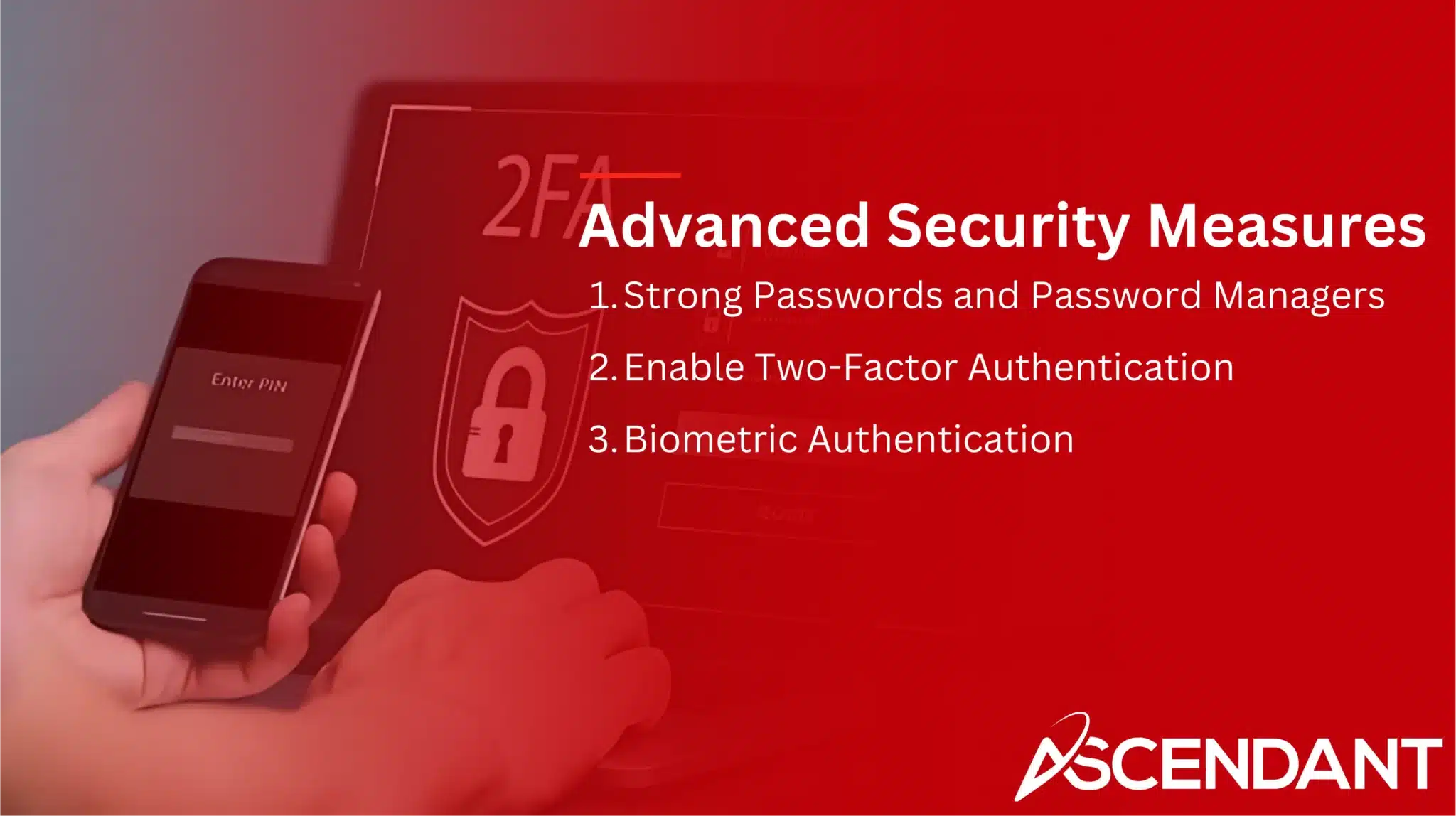Shoulder surfing is when someone watches you in public to steal your personal information, like passwords or credit card numbers. Common in places like cafes and ATMs, it can lead to serious issues like identity theft. This article will help you understand shoulder surfing, recognize its risks, and learn ways to protect yourself.
In This Article:
- Understanding Shoulder Surfing
- Common Scenarios of Shoulder Surfing Attacks
- How to Recognize Shoulder Surfing Attempts
- Consequences of Falling Victim to Shoulder Surfing
- Effective Strategies to Prevent Shoulder Surfing
- Advanced Security Measures
- Additional Tips for Protecting Sensitive Data
Key Takeaways
- Shoulder surfing poses a significant risk to personal information in public spaces, making awareness and caution crucial.
- Using privacy screens, shielding keypads, and maintaining awareness of surroundings are effective strategies to prevent shoulder surfing.
- Advanced security measures, such as strong passwords, two-factor authentication, and biometric authentication, enhance protection against identity theft.
Understanding Shoulder Surfing
Shoulder surfing is an insidious form of attack where predators stealthily observe individuals in public settings to acquire sensitive information. Utilizing tactics as basic as peering over someone’s shoulder, these contemporary thieves can effortlessly glean confidential data. This type of espionage typically takes place in densely populated locations where shoulder surfers can easily blend into the surroundings and closely monitor the actions on a person’s device, setting the stage for a potential shoulder surfing attack.
Sensitive details such as credit card numbers, PINs, and passwords are prime targets for shoulder surfers. By inconspicuously glancing at your screen in communal areas, they may gather sufficient data to inflict considerable damage. Favorite haunts for such illicit activity encompass eateries like coffee shops, banking points like ATMs, and busy settings such as public transportation systems—places where people often pay less attention to their privacy.
Remaining vigilant against possible incidences of shoulder surfing is paramount since these episodes could arise from intentional malice or mere nosiness. Regardless of its cause though, there remains an elevated risk concerning your private information security. It behooves one to exercise discretion when accessing personal information on devices while situated within public domains.
Common Scenarios of Shoulder Surfing Attacks
Attacks known as shoulder surfing are common in settings bustling with potential targets, including locales like cafés and ATM queues. In these environments, perpetrators, aptly named shoulder surfers, adeptly station themselves amidst the crowd to inconspicuously spy on displays. They may hover just within view or strike up a dialogue under false pretenses—all with the intention of stealthily acquiring your confidential data.
To delve into particular instances where one might be at risk of such incursions, consider withdrawing cash at an ATM, enjoying a beverage at a local coffee shop or traveling via public transit. These typical examples underscore our susceptibility to shoulder surfing even during routine activities that we partake in without second thought.
At ATMs
Individuals who use ATMs are often preyed upon by shoulder surfers, who watch as they input their PIN numbers and then leverage different schemes to defraud them. These perpetrators may employ tactics such as utilizing cameras or simply glancing over the target’s shoulder to capture their banking information. Occasionally, they might also resort to using binoculars or other devices that improve vision in order to conduct shoulder surfing from afar.
To lessen the danger of being targeted by these attackers, it is advisable to opt for ATMs situated within a business establishment rather than those located in exposed public areas. By making this strategic choice, one can substantially diminish the likelihood of becoming compromised by shoulder surfers intent on obtaining access to personal banking details.
In Coffee Shops
Coffee shops often attract individuals known as shoulder surfers, who are on the lookout for opportunities to glance at others’ screens with the aim of capturing sensitive information. The dense seating arrangements in these communal settings facilitate such attackers in discreetly monitoring device users who may be deeply focused on their tasks. These perpetrators commonly have objectives like inducing financial harm or committing identity theft.
When nestled amongst a throng of people in bustling coffee shops, it is imperative to remain alert and protect your screen from invasive glances. Being aware of one’s surroundings serves as an essential defense mechanism against this handful of predatory strategies prevalent in public venues.
On Public Transportation
The practice of shoulder surfing, where attackers peer over someone’s shoulder to view their screen, is especially troubling on public transportation due to the close quarters. This proximity allows these individuals to easily observe and possibly memorize login credentials, increasing the risk that they may subsequently steal the device and gain access to sensitive information. Heightened alertness in such congested environments is crucial for averting incidents of shoulder surfing.
Being mindful of who is around you and actively shielding your screen can effectively deter such invasive attempts. Although public transit offers convenience, it also necessitates heightened vigilance to safeguard one’s private information from prying eyes.
How to Recognize Shoulder Surfing Attempts
The initial phase in protecting your sensitive information involves recognizing the attempts of shoulder surfers. These types of attacks are prevalent in areas filled with people where unnoticed observation is more likely, such as coffee shops where customers sit closely together.
To fend off these invasions, it’s essential to stay vigilant about who is around you. Be wary of anyone who seems overly interested in your device or repeatedly looks at your screen without an obvious justification for being nearby. Staying alert enables you to spot possible dangers and prompts you to exercise caution when employing devices with advanced visual interfaces.
Consequences of Falling Victim to Shoulder Surfing
Becoming a target of shoulder surfing can have dire repercussions. Perpetrators may gain access to sensitive personal details, which they can exploit for identity theft and subsequently use these stolen identities to open new lines of credit or obtain loans fraudulently. This kind of attack might lead victims to suffer considerable monetary damage if the perpetrators carry out transactions without authorization, potentially emptying their bank accounts.
The aftermath of suffering from identity theft along with financial losses usually involves dedicating a substantial amount of time and effort to rectifying the situation, which could hurt credit ratings and present legal obstacles. To mitigate such risks, it is advisable that individuals consistently scrutinize their account statements and engage alert services provided by banking institutions and credit bureaus. This helps in promptly detecting any unauthorized activities on accounts thereby providing immediate notification about any suspicious actions detected.
Effective Strategies to Prevent Shoulder Surfing
To fend off shoulder surfing, it’s important to blend vigilance with tangible methods. Adopting certain postures and safeguard actions can drastically diminish the likelihood of your personal details being spotted by onlookers. For example, if you place your laptop in such a way that its screen is facing a wall or tucked into an alcove, you reduce visibility for prying eyes. Also, keeping space between yourself and large gatherings while engaging with your device serves as another key defense.
Enhancing these efforts with additional security measures can help counteract the threat posed by shoulder surfers even more effectively. The subsequent sections will delve into particular tactics like applying privacy filters to screens, concealing input devices during use and consistently remaining cognizant of one’s immediate environment to Fortify against information compromise.
Use Privacy Screens
Privacy screens serve as a barrier to restrict the visibility of screen content from anyone not within a designated viewing angle. By decreasing peripheral vision access, they thwart shoulder surfers’ attempts to glimpse your private information. Employing such a screen on your device offers an extra measure of security, particularly valuable in public settings where prying eyes pose a risk.
Securing your personal accounts and sensitive data against unwarranted observation becomes more achievable with the investment in a high-quality privacy screen. This straightforward but potent method is vital for enhancing the protection of your data.
Shield Keypads and Screens
Using your body or hand as a shield when entering sensitive information on keypads and screens is an effective technique to guard against the prying eyes of shoulder surfers. By obstructing their view while you input data, particularly in public spaces, you make it harder for them to obtain your details.
The act of physically concealing keypads and screens from view plays a crucial role in safeguarding your confidential information—such as passwords and PINs—from individuals looking to capture this data secretly. Implementing this uncomplicated precaution can greatly diminish the chance of unauthorized access to your personal info by shoulder surfers.
Maintain Awareness of Surroundings
It’s essential to maintain an alertness of your environment to recognize the risk posed by shoulder surfers. When utilizing ATMs, it is especially important to be aware of those around you and conceal your PIN during entry. These individuals might employ tools such as binoculars to obtain sensitive information from afar, hence increasing the need for attention.
Staying vigilant in relation to your immediate surroundings can assist in spotting potential instances of shoulder surfing and enable you to enact protective measures accordingly. By adopting a proactive stance, you can thwart attempts at shoulder surfing and safeguard your private data.
Advanced Security Measures
Incorporating enhanced security practices can greatly diminish the likelihood of shoulder surfing attacks, where adversaries might utilize devices such as binoculars or tiny cameras for discreet observation. The use of a VPN on shared networks acts to fortify data protection by encrypting transmitted information.
Maintaining up-to-date software and applying robust encryption aids in safeguarding sensitive data against intrusion. Subsequent sections will explore detailed strategies including the adoption of complex passwords and password managers, activation of two-factor authentication, as well as the implementation of biometric authentication techniques.
Strong Passwords and Password Managers
Strong, unique passwords are essential for securing your accounts. Unfortunately, 66% of Americans reuse the same passwords for different accounts, increasing the risk of unauthorized access if one password is compromised. Employing a unique password for each account significantly reduces this risk.
A secure password manager can be used to remember complicated passwords, making it easier to manage strong passwords securely. This tool stores and protects login credentials, providing an additional layer of security.
Enable Two-Factor Authentication
Two-factor authentication (2FA) enhances the security of an account by necessitating not just a password but also a one-time code for access. Implementing 2FA introduces an additional safeguard in the authentication process, substantially increasing difficulty for attackers attempting to gain unauthorized entry.
Rather than relying on SMS-based two-factor authentication, it is advised to choose authenticator apps like Google or Okta. These apps offer a more secure option and can markedly bolster the protection of your accounts.
Biometric Authentication
Methods of biometric authentication, including fingerprint and facial recognition technology, offer a secure means to access accounts. Although there is a danger associated with identity theft through fingerprints, the use of a secure password to biometric measures can improve overall security. The combined use of strong passwords and biometric authentication serves as an effective barrier against those seeking unauthorized access by identity thieves.
Adopting this multi-faceted approach to security reduces the likelihood of shoulder surfing incidents and safeguards sensitive information from potential compromise.
Additional Tips for Protecting Sensitive Data
Securing sensitive information extends to both physical safeguards and smart online behaviors. To shield your sensitive data from being captured by others, refrain from accessing personal accounts or conducting financial operations while connected to public Wi-Fi networks. Ensuring that devices are locked when they’re not in immediate use prevents the possibility of unapproved individuals gaining access to your data.
Consistent scrutiny of banking and other personal accounts is crucial for early detection of any aberrant transactions that could indicate identity theft or fraudulent activities. Subsequent sections will delve into detailed strategies on how to avoid using public Wi-Fi for handling delicate tasks, the importance of locking your devices when idle, and methods for vigilant monitoring of account activities for any signs of suspicious behavior.
Avoid Public Wi-Fi for Sensitive Transactions
Conducting sensitive transactions over public Wi-Fi networks can lead to substantial security risks. The lackluster security of many public Wi-Fi systems makes them prime targets for man-in-the-middle attacks, during which an attacker could intercept communications between two parties. As a result, there is a heightened danger that sensitive personal information may become compromised and fall into the hands of criminals.
To safeguard your data, refrain from accessing important accounts while connected to public Wi-Fi networks. To ensure greater protection when dealing with confidential data or engaging in sensitive activities online, it’s advisable to use your mobile phone’s hotspot or connect via a Virtual Private Network (VPN). These methods offer more secure environments for handling critical tasks and securing private information.
Lock Devices When Not in Use
Ensuring that your devices are locked when they’re not being utilized is an easy, yet crucial measure to block unapproved entry and safeguard private data. Regardless of whether it’s just for a brief interval or you have completed using your device, engaging the lock screen acts as a barrier keeping your sensitive information safe.
Regularly securing the screens on both mobile and desktop devices provides defense against those looking for chances to steal or glance at confidential details known as shoulder surfers. This routine forms an essential part of your security plan and assists in shielding delicate data from individuals who should not access it.
Monitor Accounts for Suspicious Activity
It is crucial to consistently observe your bank account and personal accounts for any signs of unauthorized activity. Vigilantly scanning your banking and credit accounts for abnormal transactions may alert you early on to potential fraud or identity theft. It’s a smart move to activate transaction alerts within your account, which will keep you promptly updated about any dubious actions.
By remaining alert and taking the initiative in overseeing your financial activities, you are able to swiftly tackle any problems that arise, safeguarding not only your finances but also ensuring the security of all related aspects. Continuous monitoring forms an integral part of preserving comprehensive protection against threats.
Summary
In essence, the threat posed by shoulder surfing attacks in our digital age cannot be overstated. It is crucial to comprehend what shoulder surfing entails, identify typical instances where it may occur, and recognize its potential repercussions for privacy preservation. Minimizing the likelihood of becoming a target can be achieved through adopting protective behaviors like using anti-spy screen protectors, covering input devices while entering data, and being conscious of who’s around when handling sensitive information.
Enhancing your security defenses with robust passwords, dual-factor authentication methods and incorporating biometric systems can offer additional layers of protection. Adhering to these recommended practices while remaining alert will enable you to shield your personal details from unauthorized scrutiny. Adopt a proactive stance towards securing yourself online. Be informed about risks and take necessary precautions against intruding gazes seeking access to your private digital activities.
 Frequently Asked Questions
Frequently Asked Questions
Is shoulder surfing illegal?
Shoulder surfing can lead to illegal activities, such as identity theft or fraud, which are prosecutable offenses. Simply observing someone may not be a crime, but using the obtained information unlawfully is subject to legal consequences.
What is an example of a shoulder surfing attack?
An example of a shoulder surfing attack occurs when a traveler in an airport lounge logs into their bank account on a laptop, and an attacker nearby uses a smartphone to capture the login credentials from the screen.
Such attacks highlight the importance of being vigilant about your surroundings when accessing sensitive information.
What is shoulder surfing and how does it occur?
Shoulder surfing is a technique used to observe and steal sensitive information by watching someone else, often taking place in crowded areas where the observer can easily peer over the victim’s shoulder or utilize tools like cameras.
It underscores the importance of being vigilant in public settings to protect personal data.
Where are common places for shoulder surfing attacks to happen?
Attacks involving shoulder surfing often take place in environments like ATM locations, cafés, and on public transit systems because people tend to be preoccupied with their devices there, which provides an opportunity for onlookers to stealthily watch what’s displayed on their screens.
Maintaining alertness in these settings is essential to safeguard one’s private data.
How can I recognize a shoulder surfing attempt?
Stay alert to your environment and keep an eye out for people who seem overly curious about your device or engage in behavior designed to divert your attention, potentially allowing them a peek at your screen.
Maintaining such awareness can assist you in safeguarding your personal information.



